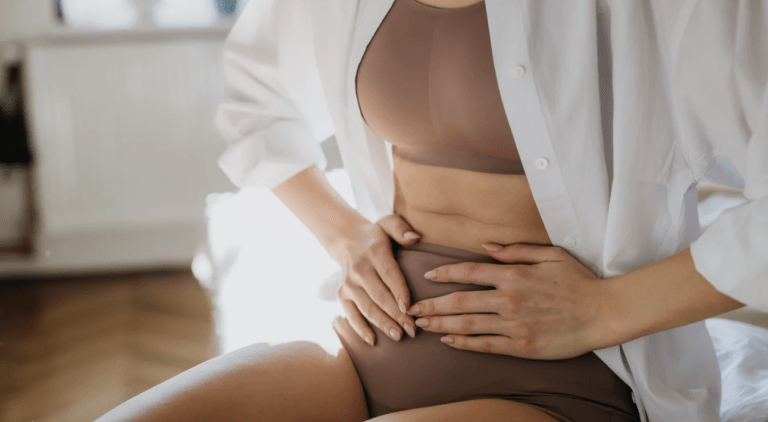- Breakthrough For Ehlers Danlos Syndrome and Endometriosis - 13 March 2025
- Does EDS get worse as you age? - 20 February 2025
- Can Ehlers Danlos Syndrome Cause Weight Gain/Loss? - 18 February 2025
Is it common for people to comment on your unusually bent elbows, calling you “double-jointed”? It’s a common expression, typically delivered with a blend of interest and laughter. However, “double-jointed” isn’t a term used in medicine. In the context of elbows, it can reveal a lot about our bodies’ adaptability, function, and struggles; it’s a layperson’s term for joint hypermobility.
When a joint is hypermobile, it can move more than its typical range of motion would allow. Some people find it endearing; it’s common in artistic pursuits like yoga, gymnastics, and dance. However, for some, it may indicate a more complicated condition, such as Hypermobility Spectrum Disorder (HSD) or Hypermobile Ehlers-Danlos Syndrome (hEDS), particularly when accompanied by pain, instability, or repeated injuries.
Hypermobility is more common than most people think, according to research. The elbow is one of the most prevalent joints afflicted, with 17.2% of school-aged children displaying hypermobility in one study. According to another study, joint hypermobility can impact as many as 40% of the population, depending on how it is classified.
But here’s where it gets tricky: some hypermobile elbow patients endure daily struggles like pain, stiffness, or even frequent subluxations (partial dislocations), while others don’t have any symptoms at all. Having “flexible” elbows isn’t enough; the strength and stability of the muscles, ligaments, and connective tissues that surround those joints is crucial.
This article covers:
ToggleWhat Does “Double-Jointed” Actually Mean?
Someone may use the term “double-jointed” to make fun of you, as if it were a clever party trick or a hidden talent. However, being “double-jointed” does not exist in the medical field. Rather, it describes a condition where a joint moves more than it normally would, a condition known as hypermobility. Flexibility is only half the story; the strength of the muscles, ligaments, and connective tissue that surround those joints is equally crucial to their stability and appearance.
Hypermobility: Beyond an Adaptive Joint
Collagen is a protein that gives our connective tissues strength and support. When its structure is different, it can lead to hypermobility, which is essentially more joint laxity. However, not every case of hypermobility is in the same category.
It is possible to have hypermobility in all of your joints, but in some cases, like your elbows, it can manifest as localised joint hypermobility (LJH).
Hypermobility Spectrum Disorder (HSD) and Hypermobile Ehlers-Danlos Syndrome (hEDS) are common causes of systemic hypermobility, which manifests in a variety of ways and impacts more than one joint.
Curiously, there is evidence that localised elbow hypermobility can manifest on its own, apart from any underlying systemic diseases. But in diseases like hEDS, hypermobility often affects more than one joint, and the elbows are no exception.
The diagnostic process, therapeutic decisions, and even day-to-day management are all aided by this differentiation. While hypermobility of the elbow may not seem like a big deal on its own, it can be an indicator of more serious issues, such as chronic pain or joint instability, if it is a symptom of a systemic condition.
How Can Hypermobility Be Quantified? Plug in the Beighton Grade
The Beighton Score is a tool that has likely been used in hypermobility assessments. It is considered the most reliable method for clinical evaluation of generalised joint hypermobility (GJH). The range of motion in various joints, such as the spine, thumbs, knees, and elbows, is assessed during the test.
Beighton Score reliability ranges from 0.74 to 0.99 within raters and from 0.72 to 0.98 between raters, according to the research. When utilised by various healthcare professionals or during multiple assessments on the same patient, these numbers demonstrate its consistency.
Although the Beighton Score has many practical applications, it does have some limitations. Because its main purpose is to identify widespread hypermobility, it may not be able to distinguish between hyperextensive elbows and other cases where no other joints are moving abnormally.
Here, knowing the difference between systemic and localised hypermobility and keeping an eye on patients in the clinic are crucial. To put it plainly: the Beighton Score is helpful, but it does not account for everything.
Distinguishing Between Systemic and Isolated Elbow Hypermobility
When contrasted with systemic hypermobility, how common is hypermobility of the elbow on its own? Athletes, dancers, and people whose jobs require them to repeatedly bend or twist their elbows may be at a higher risk of developing isolated hypermobility, according to the research.
In contrast, systemic hypermobility, as in hEDS or HSD, impacts numerous joints and is accompanied by a collection of additional symptoms, such as persistent pain, skin elasticity, gastrointestinal problems, or even autonomic dysfunction.
The close relationship between joint hypermobility (including in the elbows) and underlying tissue and joint health was demonstrated in a study that indicated 35% of patients with soft-tissue rheumatism fulfilled the criteria for generalised hypermobility.
For effective treatment and management, it is critical to understand if hypermobility in the elbows is an isolated issue or part of a systemic problem. This is more than just a technical detail. Focussing on strengthening exercises, making ergonomic adjustments, and practicing proper joint care can help with localised hypermobility. However, a more collaborative strategy incorporating experts such as rheumatologists, physiotherapists, and movement therapists may be necessary if it is a component of a condition such as hEDS.
The Anatomy of Elbows
Your elbow isn’t just a hinge—it’s a complex structure of bones, ligaments, and muscles, all working together to provide both movement and stability. But when hypermobility comes into play, this fine balance can become disrupted. And while the elbow might seem like a simple joint at first glance, its intricate design means that hypermobility here can have ripple effects throughout the arm, shoulder, and even the spine.
At its core, the elbow joint is made up of three bones:
Humerus: The upper arm bone, which forms the upper part of the elbow joint.
Radius and Ulna: The two bones of the forearm, which articulate with the humerus to allow flexion, extension, and rotation.
Together, these three bones create a hinge joint, allowing you to bend and straighten your arm. But the elbow is more than just a hinge: it also facilitates pronation (rotating your palm down) and supination (rotating your palm up). It’s a versatile joint, and it works hard in nearly every movement of your arm.
Elbow support is then provided by the medial collateral ligament (MCL), and strengthen the elbow’s exterior is the Lateral Collateral Ligament (LCL). Keep in mind that hypermobility is characterised by increased laxity of these ligaments, making them less effective at stabilising the joint. As a result, you run the risk of hyperextension, joint instability, and subluxations or dislocations more often.
On the musculoskeletal side of things, the elbow has a formidable supporting cast:
On the muscular side, the elbow is supported by a team of powerful players:
- Biceps Brachii: Flexes the elbow.
- Triceps Brachii: Extends the elbow.
- Forearm Flexors and Extensors: Help stabilize the wrist and elbow during gripping and lifting.
When the ligaments fail to provide stability, these muscles often have to work overtime. But overuse can lead to conditions like Tennis Elbow (Lateral Epicondylitis) or Golfer’s Elbow (Medial Epicondylitis)—both common in hypermobile individuals.
The Link Between Collagen
Hypermobility revolves around collagen, a protein that supports connective tissues such as ligaments and tendons. Alterations to collagen structure are common in disorders such as Hypermobile Ehlers-Danlos Syndrome (hEDS).
Ligaments may become overly elastic due to this changed collagen, which compromises their capacity to stabilise joints. The idea is the same as when you try to tie down a tent using ropes that are too elastic. Under stress, the joint becomes unstable, even though it may remain upright for some time.
The implications for elbows that are hypermobile:
- Risk of hypertension exceeding a safe range is increased.
- Lack of stability in the joints, particularly when the patient is bearing weight.
- An increase in the risk of tiredness and overuse injuries due to the increased dependence on muscles for stability.
Strength training, proprioception exercises, and protective measures (such as taping or bracing) are common approaches to collagen-related problems (more on this later).
Awareness and Proprioception in the Nervous System
Using your proprioception, the brain’s ability to sense where your body parts are in space, is like reaching for a cup of coffee without looking down at your hand. Three important nerves in the elbow help to facilitate this:
- The ulnar nerve is located on the “funny bone” the inside of the elbow.
- The sensation and movement in the back of the hand and arm are controlled by the radial nerve.
- The median nerve, which extends down the length of the arm, is responsible for regulating feeling in the palms of the hands.
Proprioception is frequently compromised in hypermobile elbows, as long term injury to ligaments can distort your brains cortical maps. When you move a joint, your brain may not receive precise information about its position. Because of this, it may be more challenging to maintain joint stability, refrain from hyperextension, or respond promptly to avoid harm.
This is why proprioceptive exercises and KT taping can be helpful; by providing the neurological system with rich sensory input, these methods allow the brain to “map” the elbow joint more precisely.
The Role of Genetics in Hypermobility
You are not alone if you have ever observed a striking similarity in the degree of joint flexibility among your immediate family members. Evidence suggests a strong hereditary component to hypermobility.
Hypermobility tends to run in families, particularly in disorders such as Hypermobile Ehlers-Danlos Syndrome (hEDS). Research points to a hereditary pattern in which hypermobility characteristics are transmitted from parents to children.
There is some evidence that hypermobility syndromes may be caused by variations in the collagen genes, specifically in the COL5A1 and COL1A1 genes. The formation and organisation of collagen fibres are regulated by these genes.
Hypermobility is a complex genetic disorder; although some cases have a single genetic mutation at their root, the majority are multifactorial, impacted by both hereditary and environmental variables.
What does this imply for elbows that are hypermobile?
When you have a genetic predisposition to connective tissue that is more elastic, your ligaments may have trouble keeping your elbow joint securely in place. This is particularly true during weight-bearing movements or repetitive motions.
Conditions Affecting Connective Tissues and Extreme Mobility
While genetics lay the groundwork, it’s the connective tissue disorders that often determine how hypermobility presents itself. Let’s take a quick look at some of the most common ones:
- Hypermobile Ehlers-Danlos Syndrome (hEDS): One of the most recognized connective tissue disorders linked to hypermobility. People with hEDS often experience significant joint instability, chronic pain, and fatigue.
- Marfan Syndrome: A genetic disorder affecting connective tissue that can result in long limbs, flexible joints, and heart complications.
- Stickler Syndrome: Another genetic disorder that impacts collagen and leads to joint hypermobility, vision problems, and hearing loss.
Each of these conditions affects the quality and structure of collagen in different ways, influencing how stable, or unstable the elbow joint becomes.
Research comparing these disorders shows clear differences in how elbow hypermobility manifests. For example:
People with connective tissue disorders often experience more pronounced proprioception deficits and chronic joint pain, making daily activities challenging.
Individuals with hEDS often report more frequent elbow subluxations and dislocations compared to those with localized hypermobility.
Common Challenges of Hypermobile Elbows
Hyperextending one’s elbows may appear innocuous or even beneficial in certain activities, such as yoga, gymnastics, or dance, to many individuals. The benefits of increased mobility aren’t without their drawbacks, though, and they can affect your daily life, your level of physical activity, and your joints’ health in the long run.
Aches and Pains:
Because they move so easily, people with hypermobile elbows might think they don’t hurt. In actuality, though, considerable pain can be caused by overuse, improper alignment, and repeated strain.
Overuse injuries: The muscles and ligaments in the area around the elbow can get overworked when you type, lift, or even just carry groceries. Conditions like tendinitis or bursitis can develop as a result of this over time.
Issues with Alignment: Maintaining correct alignment while moving becomes more challenging for people with hypermobile elbows, because of their ability to move beyond their normal range. When a joint is not properly aligned, it experiences uneven stress, which can cause localised pain and stiffness.
Because their joints are already very supple, athletes who have hypermobility are at a higher risk of overuse injuries, according to the research. Without adequate support, even simple, daily activities can cause discomfort to the joint.
Importance of Being Aware and Mindful When Moving: Repetitive strain and bad posture are common causes of hypermobile elbow pain and stiffness.
Subluxations: Hypermobile elbows frequently experience partial dislocations, in which the joint moves slightly out of its normal position. Even something as mundane as getting up from the floor or reaching for an item on a shelf can cause these. When the condition is severe enough, the joint can dislocate all the way, which usually necessitates the use of medical equipment to realign it. The gradual sensation of the elbow “giving way” when bearing weight is just as indicative of instability as more pronounced, abrupt episodes. Instability in the joints can make even the most basic of tasks, like leaning on a table, carrying a bag, or holding a plank, feel awkward.
The Chronic Pain Cycle of Repetitive Strain Injuries
These repetitive strain injuries (RSIs) can be incredibly crippling if you’ve ever dealt with Tennis Elbow (Lateral Epicondylitis) or Golfer’s Elbow (Medial Epicondylitis). Your risk of developing these conditions is significantly increased if you already have hypermobile elbows.
Inflammation of the extensor tendons causes tennis elbow, which is characterised by pain on the outer side of the elbow. Discomfort felt on the inner aspect of the elbow due to overuse of the flexor tendons; commonly known as golfer’s elbow.
Because hypermobile people’s muscles frequently have to work harder to make up for ligament laxity, RSIs are common among them. Over time, doing the same thing over and over again can lead to pain, whether you’re holding a racket, typing for long periods of time, or lifting heavy objects.
Because of the constant stress on already stretched ligaments and tendons, people who are hypermobile are at a higher risk of RSIs, according to the research.
The takeaway here is that hypermobile elbows put more stress on the surrounding soft tissues, making them more likely to sustain repetitive strain injuries (such as tennis elbow and golfer’s elbow).
The Subluxation/Dislocation Cycle
One of the most annoying and persistent problems with hypermobile elbows is the subluxation/dislocation cycle. It’s not merely about the odd “slip” of the joint; it’s about how each incident sets off a chain reaction, leading to a vicious cycle of instability, compensation, and ongoing pain.
This loop begins with a loss of stability in the joints, proprioceptive feedback, and muscle coordination. The more often it occurs, the more difficult it is to escape. We’ll break down the mechanics of this loop and see why hypermobile elbows keep having this problem.
Joint Instability: The First Domino Effect
Hypermobile elbows are characterised by ligaments that are excessively supple and fail to adequately stabilise the joint. Everyday activities, such as pushing open a door, leaning on a table, or reaching for something overhead, can force the joint to move beyond its safe range if these ligaments don’t offer enough resistance.
In contrast to a dislocation, a subluxation occurs when a joint slips out of alignment slightly but then goes back into place without medical intervention. When a joint fully dislocates from its socket, it is known as a dislocation, and it is often necessary to seek medical assistance in order to reset the joint.
Consequences: Recurrent joint slips and dislocations put additional strain on the ligaments. This reduces their future efficacy in stabilising the joint, leading to an ever-increasing state of instability.
Important Point: The elbow’s stability is compromised with each subluxation or dislocation, increasing the likelihood and difficulty of future incidents.
The Brain’s Reaction: Perceptual Disorientation
The brain receives contradictory signals whenever the elbow becomes dislocated. In order to direct movement and avoid harm, the body depends on proprioception, which is the brain’s internal “map” of the location of your joints in space. But subsequent to multiple subluxations:
Brain Misinformation: A process called cortical smudging causes the brain to receive erroneous information regarding the elbow’s position. An inaccurate and hazy mental image of the elbow joint develops. The inability to accurately anticipate the joint’s reaction to motion or stress due to a lack of clear feedback is known as motor control deficits. Symptoms such as clumsy compensatory movements, poor stabilisation, and slowed reaction times are common. The elbow is already at increased risk of slip or subluxation due to this communication breakdown.
Subluxations cause a lag between what the brain intends to do and what the body actually does because they interfere with the brain’s capacity to sense and control the joint precisely.
An Issue with Muscle Compensation:
When the ligaments in the elbow aren’t doing their job, the muscles in the area take over. This seems like a good backup plan in theory, but it causes more issues than it solves:
As a defensive mechanism against additional subluxations, the biceps, triceps, and forearm flexors muscles that surround the elbow tend to stay tight and hyperactive. This guarding is usually unconscious, but it wears out your muscles all the time.
Over time, this protective tension can develop into chronic tension and pain, causing muscle fatigue, spasms, and discomfort even when at rest.
Discordance in Biomechanics: A loss of strength occurs when one group of muscles is overused. Joint misalignment and extra stress on the spine, wrists, and shoulders can result from this imbalance.
Crucial Point: Muscles are constantly called upon by the brain to perform an unnatural task—stabilization.
And what was the outcome? Anxiety, exhaustion, and a higher probability of RSIs.
Overstimulation of the Central Nervous System
Here’s where the cycle gets even more challenging. Each time the elbow subluxates or dislocates, it triggers pain signals. Over time:
- Nervous System Sensitization: Repeated exposure to pain can cause the nervous system to become overly sensitive, a condition known as central sensitization.
- Pain Without Movement: In this state, even normal joint movements, or no movement at all, can trigger pain signals.
- Fear of Movement (Kinesiophobia): Understandably, this ongoing pain and instability can lead to a fear of movement. Individuals might start avoiding activities they once enjoyed, further reducing muscle strength and joint stability.
It’s a vicious cycle: pain leads to fear, fear leads to reduced movement, reduced movement leads to muscle weakness, and weakness leads to more instability.
Key Point: Pain isn’t just physical: it also impacts the nervous system and mindset, perpetuating the cycle of instability and fear.
Next, we’ll discuss hypermobile elbow support and protection measures, including exercises to strengthen the elbow and a KT taping technique to increase stability and decrease the likelihood of injury.
Strategies for the Proper Care of Hypermobile Elbows
Retraining your muscles and brain to work in tandem is essential for supporting hypermobile elbows, as is avoiding hyperextension. Elbow health is built on three pillars: stability, strength, and your cortical maps. KT (Kinesiology Tape) is an incredibly effective tool for addressing all three.
Just How Hypermobile Elbows Can Benefit from KT Taping:
Many of us imagine taping as a plain old physical support, like the scaffolding that keeps a building upright. When it comes to hypermobility, though, taping has a far more significant effect: it helps retrain your brain to understand the position of your joint by providing sensory feedback.
Brain Maps and Collaborative Perception:
In the cortical homunculus, your brain stores a “map” of your entire body. The term for this system is proprioception, and it allows you to know exactly where your joints are in space without ever having to look at them. This map can become hazy or skewed in hypermobility, particularly with recurrent subluxations or injuries.
KT tape serves as a highlighter on that map, providing your brain with more detailed and discernible information regarding the location of your elbow joint. This aids in stabilising the joint and preventing hyperextension while moving.
Important Point: KT tape does more than simply stabilise your joint; it also improves your brain’s capacity to “see” and manage your elbow.
How KT Tape Enhances Active Muscle Response:
The ability of KT tape to strengthen the muscles surrounding the elbow is another significant advantage. When used properly:
- To avoid hyperextension, the tape gently pulls the elbows inward.
- It lets your brain know when to contract certain muscles by way of new sensory input.
- By providing some resistance, the tape can help improve muscular tone and engagement, which in turn reduces strain on ligaments.
- By preventing the joint from collapsing into hyperextension, KT tape essentially signals to your muscles to perform their function.
Important Point: By serving as a sensory cue, KT tape enhances muscle engagement and decreases ligament strain.
Overly mobile elbows can easily become misaligned, particularly when doing weight-bearing tasks or making quick movements, which can lead to the subluxation/dislocation cycle and the use of taping.
There are two main ways in which KT tape breaks this cycle:
Physical Support: The tape’s consistent, subtle pull prevents the elbow from hyperextending, which is a common injury.
Tactile Cue: Your brain is actively involved in processing the sensory information from the tape, which enhances your awareness of the joint’s position as you move. This is known as neurological feedback.
This two-pronged strategy helps you avoid hyperextension right away while also retraining your muscles and brain to work together better in the long run.
Important Point: KT tape helps to break the cycle of instability and poor motor control by providing both physical support and neurological cues.
What You’ll Learn in the Video:
- How to measure and cut KT tape properly.
- Why a slight bend in the elbow (flexion) is essential during taping.
- How to apply the tape to gently encourage elbow flexion without restricting movement.
- Tips for making the tape last longer and remain effective during daily activities.
When it comes to managing hypermobile elbows, there’s no one-size-fits-all fix. Each elbow bend, every joint slip, and all those moments of instability tell a story about how your brain, body, and nervous system are communicating: or sometimes failing to communicate.
KT tape is one of the best tools to start bridging that communication gap.
But let’s be clear: KT tape isn’t the solution: it’s a stepping stone. It’s a way to amplify sensory feedback, sharpen your brain’s awareness of your elbow joint, and gently guide your body into safer movement patterns. It’s a cue, a reminder, and a bit of scaffolding to keep your joint steady while you focus on building strength and control.
Think of it like turning on the lights in a dim room. KT tape helps illuminate your elbow’s position and movement, giving your brain clearer signals about where it is and how to protect it. That clarity is what allows you to move into the next phase of your journey, rehabilitation, strength training, and proprioceptive exercises with confidence and reduced risk of injury.
But KT tape isn’t a forever solution. Over time, as your brain’s cortical maps become sharper, your muscles grow stronger, and your movements become more mindful, you’ll start relying on the tape less and less. And that’s the goal: to create an environment where your elbow can support itself naturally and confidently.
Your Next Steps: Building Confidence in Movement
- Watch the KT Taping Video: Learn how to apply KT tape to improve sensory feedback and reduce hyperextension.
- Incorporate Proprioceptive Exercises: Start retraining your brain to “see” your elbow joint more clearly.
- Focus on Strength Training: Build stability in the muscles that support your elbow.
Every time you tape your elbow, every time you pause to notice how your joint feels in space, and every time you engage in strengthening exercises: you’re building something. You’re rebuilding trust between your brain and your body, creating resilience in your joints, and reclaiming movement as something you can feel confident in, rather than something to fear.
So whether you’re at the start of your journey or somewhere in the middle, know this: you’re not alone, and every small step counts.
Your elbows are capable of so much more than just bending, they’re capable of supporting you, moving you, and helping you live without fear of instability.
So, tape up, stay consistent, and let’s keep moving forward, one stable, confident elbow movement at a time.
You’ve got this.
Enjoyed Our Blog? Why Stop Here?
If you’ve found value in our posts, imagine what you’ll gain from a structured, science-backed course designed just for you. Hypermobility 101 is your ultimate starting point for building strength, stability, and confidence in your body.





